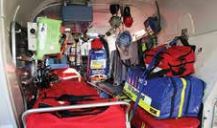
A new Airbus H145 entered service in Saskatoon last fall, and two more new aircraft will arrive in Saskatchewan by 2022. (Photo courtesy Airbus Helicopters Canada.)
Saskatchewan is known for a lot of things — the Roughriders, beautiful sunsets, pristine lakes and agriculture are just a small part of a big list.
The province also has a large and far-reaching rural population, which can present challenges when it comes to immediate access to emergency care. That’s why since its arrival in 2012 STARS has been an invaluable part of the chain of survival in Saskatchewan.
Adair O’Grady discovered the importance of STARS’ world-class critical care and rapid transport when he was injured in an accident on the family farm near Neilburg, SK, in 2015.
“My dad didn’t realize I was on the ground in front of him calibrating our new air drill, and he inadvertently drove our pickup onto my body,” Adair said.
Although he was stable, Adair suffered a number of injuries that had the potential to become lifethreatening if he didn’t get to a hospital fast. Fortunately, STARS was able to rendezvous with EMS in Cut Knife and get Adair to Saskatoon’s Royal University Hospital.
His recovery was difficult, but one year after his accident Adair was back farming with his dad.
“I’m amazed by the gifted individuals at STARS who put their hearts and lives into their jobs,” he said. “As I watch my children and my crops grow, I’m incredibly grateful.”
EMERGENCY MEDICAL CARE FOR FARMERS AND RANCHERS ACROSS THE PROVINCE

In a different part of Saskatchewan, Milt Mastad and his family were STARS supporters long before Milt needed STARS’ help.
“Where we live, we don’t have easy access to medical attention,” said Milt, who ranches near Glentworth. “I was looking at (donating to STARS) as insurance: if I support it, maybe I won’t have to use the service.”
Unfortunately, Milt did require a flight in the helicopter air ambulance when a dusky ride home took a turn for the worse. Unexpectedly, his horse bucked hard many times, severely injuring him before he could make his way to the ground. Luckily two of his daughters were riding close by, and one went back to the ranch to call for help.
Milt was in critical condition, and he needed to get to a major trauma centre quickly. STARS was able to rendezvous with the local ground ambulance, and the flight nurse and paramedic continued his care in the back of the helicopter en route to Regina General Hospital, where he underwent several surgeries and began the long road to recovery.
One year later, Milt was back in the saddle on the same horse, something that wouldn’t be possible without STARS and the donors who make the non-profit organization soar.
“Everybody in the province either already knows someone or they are going to know someone who needs the service,” he said. “I take comfort in the fact that if something happens, STARS might be there to give me medical attention again.”
MORE THAN EMERGENCY CARE IN THE AIR
STARS has highly trained critical care nurses, paramedics and transport physicians available 24/7 to care for some of the sickest and most critically injured patients throughout the province on the way from an accident scene or rural health care facility to a major trauma centre.
STARS’ helicopters are outfitted like hospital intensive care units with specialized tools including ultrasound, blood, ventilator, and point of care testing at patient side (i.e. portable lab).
Beyond the helicopter, STARS provides donor-funded mobile critical care training at no charge to rural emergency care providers throughout the province in a motorhome retrofitted with an emergency medical simulation room. The Rawlinson Mobile Education Unit was the first of its kind in North America and has provided training to more than 650 individuals in communities across Saskatchewan in the last year alone.
Community education programs are designed and led by STARS crew for first responders and municipalities to assist in landing zone safety, integrated operations support and safety in radio communications.
Every day, STARS also monitors thousands of registered remote sites, improving emergency preparedness for those working in a variety of industries, like agriculture. In the event of an emergency at a registered site, one call connects you to a STARS Communication Specialist who immediately begins to coordinate the appropriate medical response.
To learn more about how to register your farm with the STARS Emergency Link Centre, call 1-888- 888-4567.
NEW HELICOPTER FLEET INVESTMENT IN FUTURE
STARS unveiled in June 2018 its multi-year plan to replace its fleet of BK117 and AW139 aircraft with nine new medically equipped Airbus H145 helicopters, at a cost of CAD $13 million each.
“The bulk of our aging fleet are no longer being built and are becoming costlier to maintain,” said STARS president and CEO Andrea Robertson. “Additionally, independent assessments of the sustainability of our fleet told us we needed to move from two aircraft types to one.”
An extensive review resulted in the selection of the Airbus H145 aircraft as the best option for STARS’ new fleet. It offers cutting-edge technology, advanced safety features, and an updated version of the medical interior found in STARS’ existing helicopters.
Thanks to the generous support of federal and provincial government allies and early fleet supporters, STARS is well on its way to achieving its fleet renewal goal. A capital campaign continues to raise funds to replace the rest of the fleet.
The first of three new helicopters in Saskatchewan entered service in the fall of 2019, and the remaining two aircraft will be delivered by 2022.
“Our supporters ride along with us on every mission, and now they are helping us build the next STARS fleet,” said Robertson. “These new aircraft are an investment in our ability to serve the people of Western Canada for decades to come, and we’re incredibly grateful to the community for helping us get closer to our goal.”
